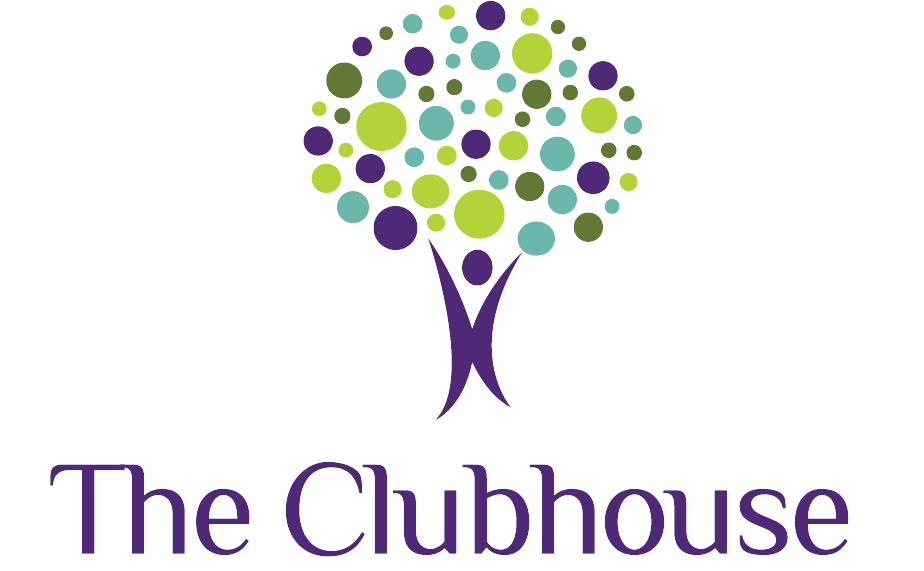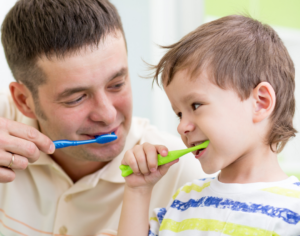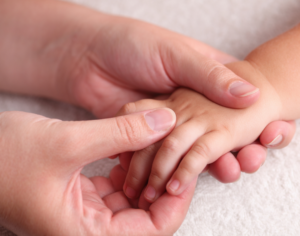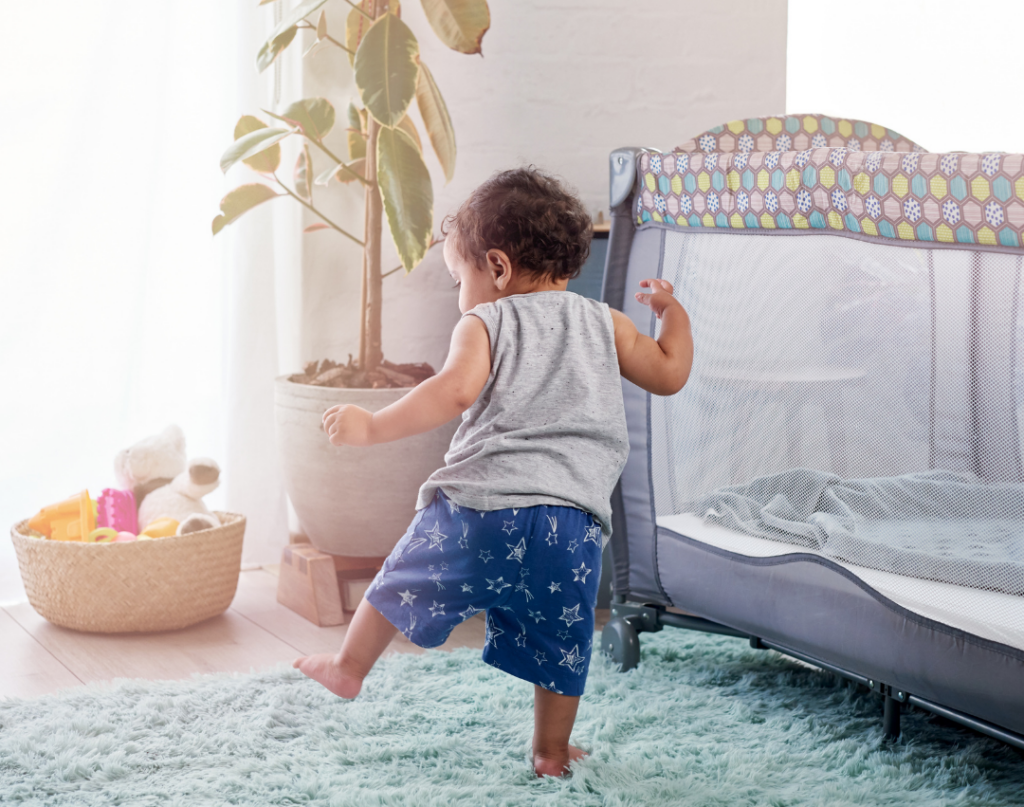Is your child on the cusp of taking their first steps, yet they don’t seem confident enough to let go of your hand? Many babies fall into the “comfort zone”: they are confidently able to cruise alongside the couch, maybe taking steps between the coffee table and a chair. They may easily walk with their hands held or explore the whole house using a push toy. If your child seems “stuck” in their reliance on these types of supports, we have some strategies to encourage standing balance and to determine if your child is ready for those independent steps yet.
First things first: in order to walk independently, you need to be able to stand independently. If your child is unable to maintain standing independently for more than a second or two before falling, this would be an indication that they need to continue working on standing balance and weight-shifting.
Improved standing balance can be achieved through exercises that promote ankle strength, hip strength, core strength, and overall stability of the body. This is why many parents will feel frustrated that their child is walking with their hands held, taking steps with a push toy, and cruising all over, yet they are not walking on their own yet. If the child cannot stand on their own, reach outside their base of support in different directions and begin to squat for toys. They aren’t going to walk independently until these areas of need are met!
Here are some ways to start encouraging standing independently, balancing longer, strengthening the right muscle groups, and increasing a child’s confidence to take steps on their own.
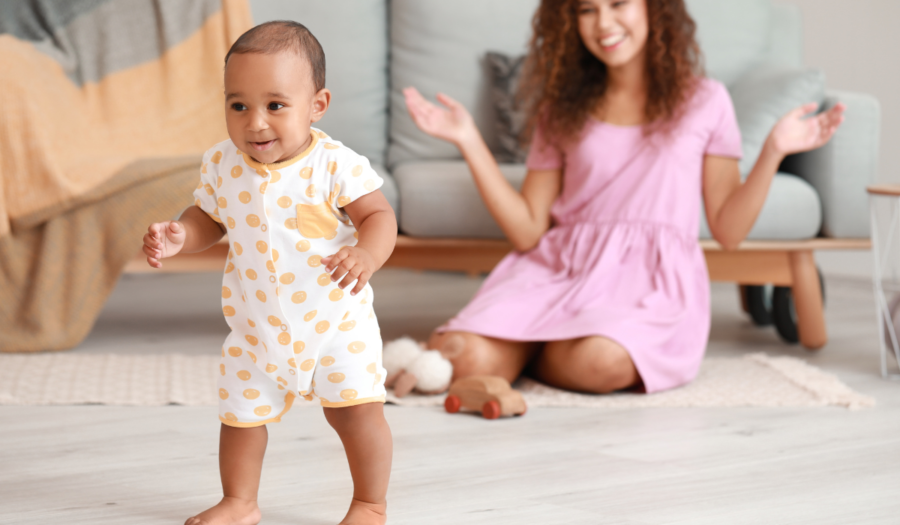
Standing while holding a mutual toy: Work on standing balance in which your child holds onto a toy, such as a plastic ring from a ring stacker, with the parent supporting the opposite end of the same toy. See if your child can maintain upright standing without direct support from you. This means that the only level of support they’re getting is from the “mutual” toy that you’re both holding onto.
Rings work really well, but you can also try using a sturdy cardboard book, a piano toy, a shape sorter box, etc. Really, any toy that the child is engaged in can work if the parent is able to hold the opposite end of it. If this becomes too easy, try two rings (one in each hand) and try taking steps while you and your baby are both holding onto the rings.
Get Started With Physical Therapy
Standing while distracted: Sometimes a child is able to stand for more than a few seconds on their own, but it might be really inconsistent. This is where the “distraction factor” comes in handy! Many babies are hyper-aware when a parent (or therapist!) lets go of their hand, causing them to instantly sit back down. If the child can be distracted by something, they can often remain standing longer and longer without even noticing what they’re doing.
Try blowing bubbles and having them watch the bubbles float around or reach to pop them. If they enjoy music, try playing a song or singing to them while they stand. If they really zone in when being read to, break out their favorite storybook and have them stand while you read, perhaps having them reach to turn the pages. You can also blow up a balloon and have them hold onto it or tap it into the air to distract them while they stand.
Try giving support without directly holding their hand: It helps to start standing with support somewhere besides holding your child’s hand. Hold their elbow instead, as they are less likely to notice when you let go. Try placing a small toy (like a shape from the shape sorter toy) inside each hand and hold their elbows, then let go completely. Your child’s grip on the small toy in their hand can be enough to offer a sense of stability, so much that they may not realize you’ve removed your hold on them. *Cue the bubbles, balloon, songs for distraction*
Proprioception can be key: Proprioception is the body’s sense of awareness in space. It’s the sense that lets the body feel your feet on the ground and each joint stacked in postural alignment, with pelvis over knees, knees over ankles, feet planted on the floor, etc. Your child is still developing their proprioceptive system, so they are still reliant on their visual system and somatosensory systems (sense of touch, vibration). This means that they sometimes benefit from some added proprioceptive input in order to know where their body is in space and to feel the floor underneath their feet.
Gentle pressure through the pelvis/hips in a downward and inward direction can act as the added proprioceptive input they need to remain standing for longer bouts. In standing, you can also try gentle pressure at the opposite shoulder and opposite side of the pelvis, switching between sides. The pressure should be firm but not forceful.
Keep their hands low: If you do prefer to practice taking steps with hands held, you should ensure that your child’s hands remain at or below the level of their shoulder. Holding your child’s hands above their head encourages a great deal of “hanging” on the joints for support rather than activating muscles to get stronger. Parents are tall; babies are not! This drastic difference in height is what leads many parents to hold their child’s hands way above their head while taking steps with them. Physical therapists encourage caregivers to hold the child’s hands much lower to promote equal weight-bearing and activation of the core, making it more similar to walking without assistance. Again, try changing hand placement so your baby doesn’t become overly reliant on having their hand held. Hold their elbow or support their trunk instead to change it up. This can make a huge difference.
Please note: If your child seems to be delayed with milestone acquisition and is not bearing weight through their legs, consult with a physical therapist to determine the best course of action. If your child has a neurological diagnosis, they may benefit from adaptive equipment in order to work on weight-bearing positions, weight-shifting, or assisted stepping. Examples of adaptive equipment include standers, gait trainers, orthotics, etc. If you are in doubt, avoid the “wait and see” approach! Look into scheduling a PT screening to help guide you and best support your child’s development.
Written by Jessica Tarence PT, DPT
Have any additional questions or concerns? Check out our Physical Therapy page for more information, or contact us to learn more about our free physical therapy screenings!
